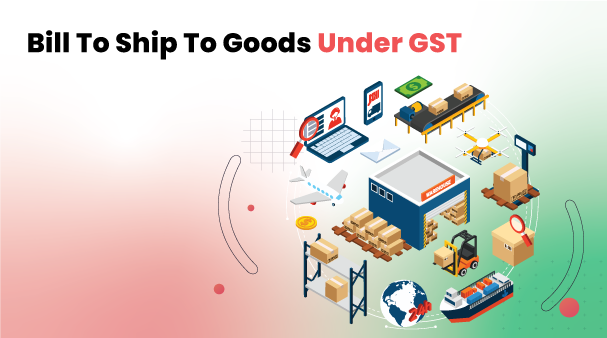Under GST, many multilocational units are consolidating their operations and warehouses as the tax incidence for inter-state and intra-state being the same, but for the nomenclature as IGST or CGST+SGST. The other operational reasons may also influence the decision viz., availability of raw materials, travel logistics and costs, locational advantage etc. Hence bill to ship to transactions have become order of the day. In this article we are going to discuss the various scenarios of bill to ship to transactions under GST for supply of goods.
Concept of Constructive delivery has been introduced vide introduction of explanation to Sec 16(2) of CGST Act, 2017 and is equally applicable for both goods and services and reads as under:
“Explanation.—For the purposes of this clause, it shall be deemed that the registered person has received the goods or, as the case may be, services–
(i) where the goods are delivered by the supplier to a recipient or any other person on the direction of such registered person, whether acting as an agent or otherwise, before or during movement of goods, either by way of transfer of documents of title to goods or otherwise;
(ii) where the services are provided by the supplier to any person on the direction of and on account of such registered person.”;
Let us consider the below points, which will help us in the discussion. Any Bill to Ship to transaction has three parties to it. They are
1) The ultimate customer (UC) may include a distributor also
2) Marketing Agent (MA) may include the ordering agent also
3) Original supplier (OS) could be a manufacturing company, distributor or job worker
The bill to ship to transaction will be complete only when there are two taxable supplies. There will be supply of goods from the original supplier (OS) to the ultimate consumer (UC), but OS invoices to MA. Later MA will invoice to UC without any goods being supplied. Hence there will be only one movement of goods, but exchange of taxable invoices will happen twice.
The various practical scenarios and their taxability is as under
|
S.No. |
Original Supplier (OS) being |
Marketing Agent (MA) being |
Ultimate Customer (UC) being |
Tax applicability for supply from OS to MA |
Tax applicability for supply from MA to UC |
Goods movement from OS to UC |
|
01 |
DTA in State A |
DTA in State A |
DTA in State A |
CGST+SGST of State A |
CGST+SGST of State A |
Intra-state |
|
02 |
DTA in State A |
DTA in State A |
DTA in State B |
CGST+SGST of State A |
IGST of State A |
Inter State |
|
03 |
DTA in State A |
DTA in State B |
DTA in State A |
IGST of State A |
IGST of State B |
Intra-state |
|
04 |
DTA in State A |
DTA in State B |
DTA in State B |
IGST of State A |
CGST+SGST of State B |
Inter State |
|
05 |
SEZ |
DTA |
DTA |
MA or UC can file BoE. |
CGST+SGST if both MA and UC are in same state or IGST if they are in different states. |
DTA supply by SEZ |
|
06 |
SEZ |
DTA |
SEZ |
BoE without import duties |
As above |
Inter unit transfer between two SEZs |
|
07 |
SEZ |
DTA |
EOU |
BoE by UC, but the procurement certificate will be for the value in Invoice from MA to UC |
As above |
Supply from SEZ to EOU |
|
08 |
EOU |
DTA |
DTA |
CGST+SGST if both OS and UC are in same state or IGST in other cases. OS being an EOU will reverse pro-rated import duties on the inputs used in the finished goods (FG). |
As above |
Intra-state or Inter-state |
|
09 |
EOU |
DTA |
SEZ |
Shipping Bill to be filed by OS to UC |
As above |
Supply to SEZ |
|
10 |
EOU |
DTA |
EOU |
BoE by UC, but the procurement certificate will be for the value as per Invoice from MA to UC |
As above |
Intra-state or Inter-state |
|
11 |
DTA |
Outside India |
DTA |
CGST+SGST if both OS and MA are in same state or IGST otherwise. |
As above |
Intra-state or inter-state |
|
12 |
DTA |
Outside India |
EOU |
BoE by UC, but the procurement certificate will be for the value in Invoice from MA to UC |
As above |
Intra-state or inter-state |
|
13 |
DTA |
Outside India |
Outside India |
SB to be filed by OS |
Commercial invoice between MA and UC |
Export |
|
14 |
DTA |
DTA |
Outside India |
Merchant export transaction at concessional rate of GST |
Export invoice from MA to UC |
Export |
|
15 |
SEZ |
Outside India |
Outside India |
SB to be filed by OS |
Commercial invoice from MA to UC |
Export |
|
16 |
SEZ |
Outside India |
DTA |
BoE by UC; MA can also file the BoE provided DGFT permits him IEC. |
CGST+SGST if both MA and UC are in same state otherwise IGST if they are in different states. |
DTA Supply from SEZ |
|
17 |
SEZ |
Outside India |
EOU |
As above |
As above |
SEZ supply to EOU |
|
18 |
EOU |
Outside India |
DTA |
CGST+SGST, if OS and MA are in same state; IGST if they are in different states |
As above |
Intra-state or inter-state |
|
19 |
EOU |
Outside India |
EOU |
As above |
As above |
Intra-state or inter-state |
|
20 |
EOU |
Outside India |
SEZ |
Shipping bill to be filed by EOU |
As above |
Supply to SEZ |
The following points may also be kept in mind while undertaking the above transactions
1. SEZ/EOU cannot be a trader as buying and selling are not permitted authorized activities
2. In all these cases, it is presumed that all three parties are registered under GST. Since GST has introduced the concept of “non-resident taxable person” means any person who occasionally undertakes transactions involving supply of goods or services or both, whether as principal or agent or in any other capacity, but who has no fixed place of business or residence in India. Accordingly MA needs to take registration while effecting these transactions.
3. Currently DGFT does not permit MA, who is outside India to have IEC on the lines of GST registration using an agent in India and hence it needs to be clarified by the authorities.
4. Some of the above transactions are not practical in the field as the margins made by MA will be transparent to the UC. Instead, it is suggested to adopt commission agent model in all such cases.
5. In some of these cases, seamless credit flow of ITC will not be there as BCD as import component will be a cost to company. This needs to be handled separately in commercial terms.
6. There can be issues when UC files the BoE based on the value of invoice issued by OS to MA, but this is permitted in the field by Customs.

